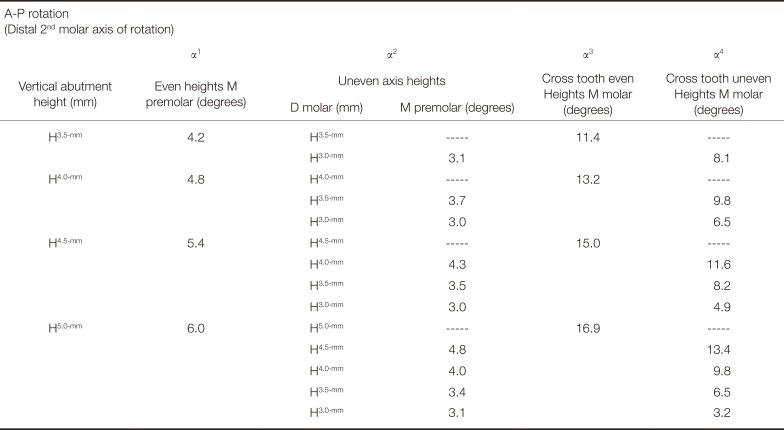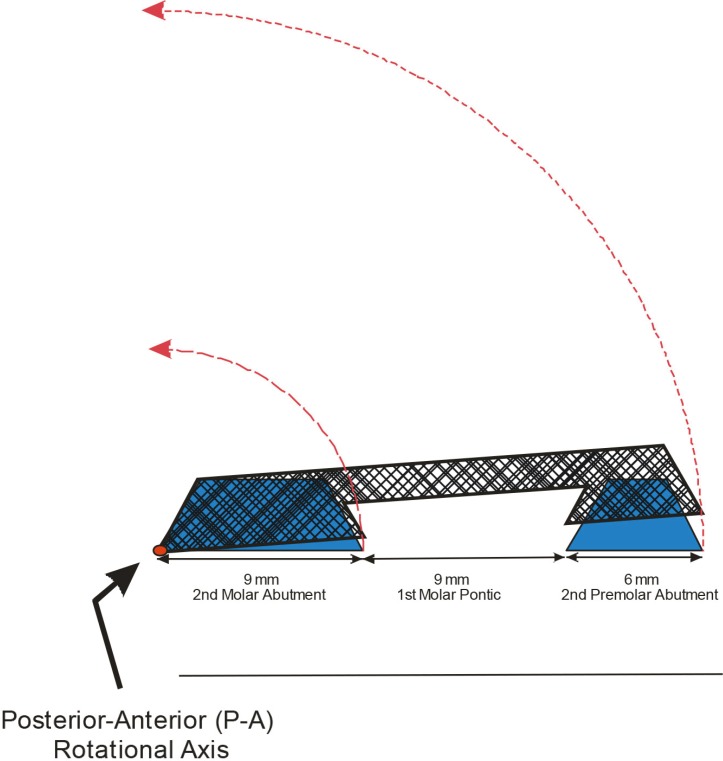1. The Glossary of prosthodontic terms. J Prosthet Dent. 2005; 94:10–92. PMID:
16080238.
2. Prothero JH. Prosthetetic dentistry. Chicago: Medico-Dental Publishing Co;1923. p. 1128.
3. Dykema RW, Goodacre CJ, Phillips RW. Johnston's modern practice in fixed prosthodontics. Philadelphia: Saunders;1986. p. 22–27.
4. Shillingburg HT, Jacobi R, Brackett SE. Fundamentals of tooth preparations for cast metal and porcelain restorations. Chicago: Quintessence;1987. p. 13–31.
5. Malone FP, Koth DL. Tylman's theory and practice of fixed prosthodontics. 8th ed. St. Louis: Ishiyaku EuroAmerica;1989. p. 113–143.
6. Rosenstiel SF, Land MF, Fuijimoto J. Contemporary fixed prosthodontics. 4th ed. St. Louis: Mosby;2006. p. 226–257.
7. Goodacre CJ, Campagni WV, Aquilino SA. Tooth preparations for complete crowns: an art form based on scientific principles. J Prosthet Dent. 2001; 85:363–376. PMID:
11319534.

8. Kaufman EG, Coelho DH, Colin L. Factors influencing the retention of cemented gold castings. J Prosthet Dent. 1961; 11:487–502.

9. Nicholls JI. Crown retention. Part I. Stress analysis of symmetric restorations. J Prosthet Dent. 1974; 31:179–184. PMID:
4520666.

10. Hegdahl T, Silness J. Preparation areas resisting displacement of artificial crowns. J Oral Rehabil. 1977; 4:201–207. PMID:
268415.

11. Woolsey GD, Matich JA. The effect of axial grooves on the resistance form of cast restorations. J Am Dent Assoc. 1978; 97:978–980. PMID:
363771.

12. Mack PJ. A theoretical and clinical investigation into the taper achieved on crown and inlay preparations. J Oral Rehabil. 1980; 7:255–265. PMID:
6995565.

13. Potts RG, Shillingburg HT Jr, Duncanson MG Jr. Retention and resistance of preparations for cast restorations. J Prosthet Dent. 1980; 43:303–308. PMID:
6986461.

14. Weed RM, Baez RJ. A method for determining adequate resistance form of complete cast crown preparations. J Prosthet Dent. 1984; 52:330–334. PMID:
6384470.

15. Dodge WW, Weed RM, Baez RJ, Buchanan RN. The effect of convergence angle on retention and resistance form. Quintessence Int. 1985; 16:191–194. PMID:
3887460.
16. Zuckerman GR. Factors that influence the mechanical retention of the complete crown. Int J Prosthodont. 1988; 1:196–200. PMID:
3074808.
17. Zuckerman GR. Resistance form for the complete veneer crown: principles of design and analysis. Int J Prosthodont. 1988; 1:302–307. PMID:
3075911.
18. Parker MH, Gunderson RB, Gardner FM, Calverley MJ. Quantitative determination of taper adequate to provide resistance form: concept of limiting taper. J Prosthet Dent. 1988; 59:281–288. PMID:
3279183.

19. Nordlander J, Weir D, Stoffer W, Ochi S. The taper of clinical preparations for fixed prosthodontics. J Prosthet Dent. 1988; 60:148–151. PMID:
3172001.

20. Zuckerman GR. Analysis of resistance and retention of complete veneer crown retainers. Quintessence Int. 1990; 21:629–635. PMID:
2094865.
21. Parker MH, Malone KH 3rd, Trier AC, Striano TS. Evaluation of resistance form for prepared teeth. J Prosthet Dent. 1991; 66:730–733. PMID:
1805019.

22. Parker MH, Calverley MJ, Gardner FM, Gunderson RB. New guidelines for preparation taper. J Prosthodont. 1993; 2:61–66. PMID:
8374714.

23. Kamposiora P, Papavasilious G, Bayne SC, Felton DA. Finite element analysis estimates of cement microfracture under complete veneer crowns. J Prosthet Dent. 1994; 71:435–441. PMID:
8006836.

24. Wiskott HW, Nicholls JI, Belser UC. The relationship between abutment taper and resistance of cemented crowns to dynamic loading. Int J Prosthodont. 1996; 9:117–139. PMID:
8639233.
25. Wiskott HW, Nicholls JI, Belser UC. The effect of tooth preparation height and diameter on the resistance of complete crowns to fatigue loading. Int J Prosthodont. 1997; 10:207–215. PMID:
9484051.
26. Augereau D, Renault P, Pierrisnard L, Barquins M. Three-dimensional finite element analysis of the retention of fixed partial dentures. Clin Oral Investig. 1997; 1:141–146.

27. Trier AC, Parker MH, Cameron SM, Brousseau JS. Evaluation of resistance form of dislodged crowns and retainers. J Prosthet Dent. 1998; 80:405–409. PMID:
9791785.

28. Wiskott HW, Krebs C, Scherrer SS, Botsis J, Belser UC. Compressive and tensile zones in the cement interface of full crowns: a technical note on the concept of resistance. J Prosthodont. 1999; 8:80–91. PMID:
10740506.

29. Zidan O, Ferguson GC. The retention of complete crowns prepared with three different tapers and luted with four different cements. J Prosthet Dent. 2003; 89:565–571. PMID:
12815350.

30. Proussaefs P, Campagni W, Bernal G, Goodacre C, Kim J. The effectiveness of auxiliary features on a tooth preparation with inadequate resistance form. J Prosthet Dent. 2004; 91:33–41. PMID:
14739891.

31. Parker MH. Resistance form in tooth preparation. Dent Clin North Am. 2004; 48:387–396.

32. Bowley JF, Sun AF, Barouch KK. Effect of margin location on crown preparation resistance form. J Prosthet Dent. 2004; 92:546–550. PMID:
15583560.

33. Cameron SM, Morris WJ, Keesee SM, Barsky TB, Parker MH. The effect of preparation taper on the retention of cemented cast crowns under lateral fatigue loading. J Prosthet Dent. 2006; 95:456–461. PMID:
16765159.

34. Bowley JF, Kieser J. Axial-wall inclination angle and vertical height interactions in molar full crown preparations. J Dent. 2007; 35:117–123. PMID:
16911851.

35. Bowley JF, Lai WF. Surface area improvement with grooves and boxes in mandibular molar crown preparations. J Prosthet Dent. 2007; 98:436–444. PMID:
18061737.

36. Bowley JF, Ichim IP, Kieser JA, Swain MV. FEA evaluation of the resistance form of a premolar crown. J Prosthodont. 2013; 22:304–312. PMID:
23279111.

37. Lial ML, Schneider DI, Hornsby EJ. College algebra and trigonometry. New York: ddison-Wesley;2004. p. 472–531.












 PDF
PDF ePub
ePub Citation
Citation Print
Print








 XML Download
XML Download